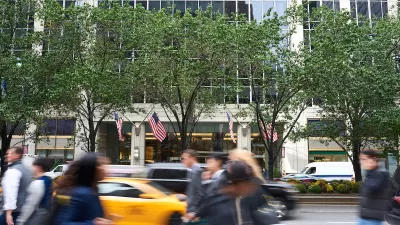A new law doesn’t fully decriminalize jaywalking, but bars law enforcement from issuing citations to pedestrians when crossings aren’t ‘truly dangerous.’

Pedestrian advocates have long criticized jaywalking laws as a tool for asserting the dominance of the car on American roads and deprioritizing the needs of other road users. Now, states like California are recognizing the harmful effects of jaywalking criminalization, writes Peter Norton in an opinion piece for the Los Angeles Times.
As Norton points out, “California’s new Freedom to Walk Act does not exactly decriminalize jaywalking. It leaves plenty of room for police discretion to ticket unsafe walking, and it doesn’t challenge cars’ domination of city streets.” But the law does acknowledge the need to make walking safer in other, less punitive ways that improve infrastructure and road conditions rather than punish pedestrians.
Norton outlines the rise of the automobile and, consequently, jaywalking laws, which became the norm after a strong lobbying effort from motor vehicle interests who explicitly called for “a radical revision of our conception of what a city street is for.” Norton walks the reader through the history of jaywalking laws in Los Angeles, where the first regulations took hold. According to Norton, “Their effort to protect their market for automobiles left us a legacy of highly restricted walking and the notion that streets are primarily for cars.”
Now, Norton writes, the Freedom to Walk Act, which limits enforcement of jaywalking regulations, is a step in the right direction to reclaim roads and shift the focus of road safety efforts to encourage more walking and multimodal transportation.
FULL STORY: Op-Ed: L.A. invented jaywalking tickets to serve cars. It's time to give streets back to walkers

Trump Administration Could Effectively End Housing Voucher Program
Federal officials are eyeing major cuts to the Section 8 program that helps millions of low-income households pay rent.

Planetizen Federal Action Tracker
A weekly monitor of how Trump’s orders and actions are impacting planners and planning in America.

Ken Jennings Launches Transit Web Series
The Jeopardy champ wants you to ride public transit.

Washington Legislature Passes Rent Increase Cap
A bill that caps rent increases at 7 percent plus inflation is headed to the governor’s desk.

From Planning to Action: How LA County Is Rethinking Climate Resilience
Chief Sustainability Officer Rita Kampalath outlines the County’s shift from planning to implementation in its climate resilience efforts, emphasizing cross-departmental coordination, updated recovery strategies, and the need for flexible funding.

New Mexico Aging Department Commits to Helping Seniors Age ‘In Place’ and ‘Autonomously’ in New Draft Plan
As New Mexico’s population of seniors continues to grow, the state’s aging department is proposing expanded initiatives to help seniors maintain their autonomy while also supporting family caregivers.
Urban Design for Planners 1: Software Tools
This six-course series explores essential urban design concepts using open source software and equips planners with the tools they need to participate fully in the urban design process.
Planning for Universal Design
Learn the tools for implementing Universal Design in planning regulations.
Heyer Gruel & Associates PA
Ada County Highway District
Institute for Housing and Urban Development Studies (IHS)
City of Grandview
Harvard GSD Executive Education
Toledo-Lucas County Plan Commissions
Salt Lake City
NYU Wagner Graduate School of Public Service





























